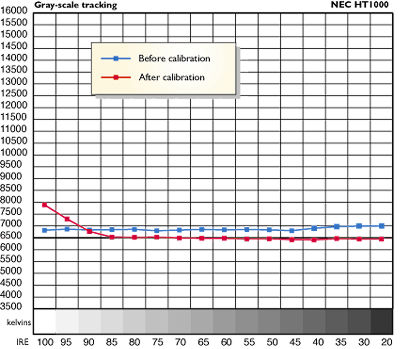NEC HT1000 DLP projector Calibration

In 16:9 mode and with its overscan set to "0%," the NEC HT1000 overscanned by 2% top and bottom and by 1% left and right. Black-level retention was excellent. Horizontal resolution on DVD was 500 lines per picture height. The fan noise in EcoMode (which I used for all of my tests) was remarkably low—as quiet as any digital projector we've tested. Despite the NEC's small size, only a little stray light came from the case, mainly on the right side (when facing the screen).
After a full calibration and with the video controls set for the best overall picture, the HT1000's full-on/full-off contrast on my 80-inch-wide, 16:9 Stewart FireHawk screen measured 1133 with the iris open, 2313 with it closed. Closing the iris reduced the peak white level from 12.6fL open to 9.2fL closed (27%), but it also dropped the footlambert reading for the minimum black level (off) by more than 50%—hence the significant improvement in peak contrast.
The contrast from a 16-square black/white checkerboard image was less affected by this, measuring 116 with the iris open, 111 with it closed. But the checkerboard reading is more likely to be affected by room reflections. As we've noted before, although our contrast measurements are made in a completely darkened room, the surroundings are not completely black. (NEC enclosed a note with the projector recommending that the person taking the contrast measurements wear black clothing. I have to admit that I was unable to be quite so paranoid.) Nevertheless, with the iris closed, the picture-off black level was the best I have yet measured from a digital projector, beating even the HD2-chipped Marantz by 20%.
For my gray-scale measurements, I set up the HT1000 using its White Balance controls and leaving the Color Correction controls at their factory defaults (red = 0, green = 0, blue = 6, yellow = 7, magenta = "–15, cyan = "–2). The results are shown in the accompanying graph. The After results are closer to the ideal below 85 IRE. But the Before readings (the factory 6500K setting) are also very good—and better than the custom setup at high IRE levels. In fact, the picture in the custom setup (the After curve) exhibited a slight pinkish cast similar to the color shift I observed on the SIM2 HT300 Plus (reviewed in May 2003). As with that projector, the color shift was clearly visible only on test patterns. But for some program material I actually preferred the factory 6500K setting.
Reds on the HT1000 deviated very slightly toward pinkish red, which may have had a hand in the slight pink shift. They were also very slightly orange—common in video displays. Green was shifted slightly toward yellow green, and blue edged a bit toward greenish blue. None of these deviations was any worse than those we have measured on most other DLP projectors. Our eyes can easily adjust to a reasonable range of deviation, and the NEC certainly falls within that range.
All color measurements and calibrations were made with a Photo Research PR-650 spectroradiometer; contrast was measured with a Minolta LS-100 light meter reading in footlamberts.—TJN























































